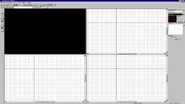WorldCraft is an editor made for Quake by Ben Morris on September 20, 1996. This editor utilized the power of Direct3D for Windows 95. Unlike most other Quake editors, WorldCraft was made with a commercial interest, meaning legal distributions are for the shareware release. It was planned for the commercial CD release of WorldCraft to begin shipping in November of 1996; the price would have been around US $33.00. Selling levels made with WorldCraft would require a commercial license, a fee around the same cost as an office software package. WorldCraft only legally permits usage for 30 days, after which the user must register or stop using the program.
WorldCraft was originally known as The Forge. The name had to be changed due to said editor also being the name for the editor for Marathon.
Quickly gaining a high level of popularity alongside THRED, WorldCraft soon outpaced the other editor due to a high level of support. IRC classes were hosted weekly to teach people the editor, as well as find out tricks in regards to level editing. Combined with a highly interconnected community, including numerous level designers offering insight to their design methods, WorldCraft was popularized for having a better learning curve and better resources available than other editors of its time.
WorldCraft featured CSG, Constructive Solid Geometry, techniques. Other level editors of the time, such as THRED, were subtractive; they carved away from an indefinitely solid block to create hollow rooms. WorldCraft on the other hand was additive, meaning the world was an empty void and the level would be built up with a lot of small "building blocks" and simple geometry. Subtractive editors tended to be the more popular choice for old-school gaming as a room could be created a lot quicker, additive editors require every brush to be placed (meaning a simple room requires six blocks, four for the walls and two for the ceiling and floor) and the designer has to be aware of possible "leaks" into the void that would prevent the level from functioning. However, the building block nature of additive editors means that it is generally considered easier to detail an environment, subtractive can require numerous levels of carving and solidifying portions to obtain the same level of detail.
To hollow out a doorway, the designer would use a "carving" feature that would take the position of a brush and cut away from the solid environment. This brush was not limited in the type of shape required, meaning it could be a cube, cylinder, or wedge,
WorldCraft also included a feature that could build a level using QBSP. Simply pressing F9 would compile the level and start it in Quake.
This editor gained enough traction for Valve to take notice and utilize it on their GoldSrc engine. This editor eventually evolved into the Valve Hammer Editor.
Levels
See Category:WorldCraft levels


